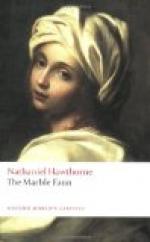A marvellous repose—that rare merit in statuary, except it be the lumpish repose native to the block of stone—was diffused throughout the figure. The spectator felt that Cleopatra had sunk down out of the fever and turmoil of her life, and for one instant—as it were, between two pulse throbs—had relinquished all activity, and was resting throughout every vein and muscle. It was the repose of despair, indeed; for Octavius had seen her, and remained insensible to her enchantments. But still there was a great smouldering furnace deep down in the woman’s heart. The repose, no doubt, was as complete as if she were never to stir hand or foot again; and yet, such was the creature’s latent energy and fierceness, she might spring upon you like a tigress, and stop the very breath that you were now drawing midway in your throat.
The face was a miraculous success. The sculptor had not shunned to give the full Nubian lips, and other characteristics of the Egyptian physiognomy. His courage and integrity had been abundantly rewarded; for Cleopatra’s beauty shone out richer, warmer, more triumphantly beyond comparison, than if, shrinking timidly from the truth, he had chosen the tame Grecian type. The expression was of profound, gloomy, heavily revolving thought; a glance into her past life and present emergencies, while her spirit gathered itself up for some new struggle, or was getting sternly reconciled to impending doom. In one view, there was a certain softness and tenderness,—how breathed into the statue, among so many strong and passionate elements, it is impossible to say. Catching another glimpse, you beheld her as implacable as a stone and cruel as fire.
In a word, all Cleopatra—fierce, voluptuous, passionate, tender, wicked, terrible, and full of poisonous and rapturous enchantment—was kneaded into what, only a week or two before, had been a lump of wet clay from the Tiber. Soon, apotheosized in an indestructible material, she would be one of the images that men keep forever, finding a heat in them which does not cool down, throughout the centuries?
“What a woman is this!” exclaimed Miriam, after a long pause. “Tell me, did she ever try, even while you were creating her, to overcome you with her fury or her love? Were you not afraid to touch her, as she grew more and more towards hot life beneath your hand? My dear friend, it is a great work! How have you learned to do it?”
“It is the concretion of a good deal of thought, emotion, and toil of brain and hand,” said Kenyon, not without a perception that his work was good; “but I know not how it came about at last. I kindled a great fire within my mind, and threw in the material,—as Aaron threw the gold of the Israelites into the furnace,—and in the midmost heat uprose Cleopatra, as you see her.”
“What I most marvel at,” said Miriam, “is the womanhood that you have so thoroughly mixed up with all those seemingly discordant elements. Where did you get that secret? You never found it in your gentle Hilda, yet I recognize its truth.”




